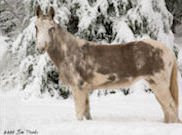RESTORE STOCK ACCESS TO THE PACIFIC CREST TRAIL
COMMENT NOW (The comment period only runs through April)
Restoration of stock access through the Glacier Peak Wilderness on the Pacific Crest Trail remains to this day not passable. This truly compromises the stock and hiker purpose of the historic trail. The Pacific Crest Trail is one of the two original trails (the other being the Appalachian Trail) authorized under the National Trails System Act of 1968, making it just about as old as another famous congressional piece of legislation, the Wilderness Act of 1964.
We want to very much wholeheartedly thank each of our members who took the time to comment on the 2008 scoping letter. HOWEVER, there are many members that we think missed the opportunity (the comments are listed by person in the EA). Rather than chastise you, we are GIVING YOU ANOTHER CHANCE!!!
The MBS has now posted an Environmental Assessment (EA) on their website with a 30 day comment period further defining the input received in the 2008 scoping letter. DO YOU WANT THE PCT TO REMAIN A STOCK TRAIL? Hikers have been able to use the rather dangerous footlogs across the river, so we are the most impacted user group. It is time to send in your comments NOW!!!
Alternative 1 – No Action (This is not acceptable as it means no stock passing on the PCT.)
Alternative 2 – Use a helicopter and rock drills for reestablishing a new bridge. ALSO, use chainsaws and a mini-excavator for constructing the new trail access segments.
Alternative 3 – Use a helicopter and rock drills for reestablishing a new bridge. Use traditional non-mechanical methods for constructing the new trail access segments.
BCHW Review: While Alternative 3 is by far the most appealing from a baseline Wilderness use principle, it would require a much longer period to implement than using chainsaws and a mini-excavator and would require much more rock blasting. Based on overall impacts as the MBS analysis shows, the use of chainsaws to complete 3.5 miles of new trail is clearly justified. The use of a non-handheld tracked mini-excavator is more debatable for appropriate use in the Wilderness. When you look at weighing the short term use of this excavator over multi-season blasting and large camps for user crews, the MBS has made a good argument for utilizing this piece of equipment. (Use should be kept as minimalistic as possible confined to where other routing and traditional construction options aren't reasonably possible.)
We therefore recommend the following (include in your words in your comments):
1. Alternative #1 (no action) of the Pacific Crest Trail Repair Suiattle River Crossing Environmental Assessment is not an option. Access for the Pacific Crest Trail across the Suiattle River must be re-established by construction of a new bridge in a sustainable site – as identified in Alternatives #2 and #3. A new bridge is the only safe solution both for stock users and for hikers trying to cross the river.
2. Alternative #2 is our preferred option. A new bridge must be constructed and moved to the site. Using pack stock to move materials for the new bridge is not feasible as even the Suiattle River Road is washed out and there are no other access options. Use of a helicopter to move materials is fully justified, and no landings of the helicopters in the Wilderness will occur. Power rock drills are the most functional method to anchor the bridge. The significant amount of new trail construction to access the bridge site justifies the use of chainsaws. The savings in impacts from rock blasting, stump removal, and large crew impacts justifies the use of a mini-excavator.
3. Alternative #3 is our less preferred option. It does replace the bridge as in Alternative #2 – and that is the most critical component. However, without considerable resources, it would make the new trail construction much more difficult and drag it out over a number of seasons.
SEND IN YOUR SUPPORT NOW!!! Your names will be joining the dedicated names of our members who have acted in prior years (published in the EA Pages 47-48) and whom we hope will follow up with another comment in this third year of this effort. Show your support for stock use in Washington State on the Pacific Crest Trail.
Send your comments to Dawn Erickson, Team Leader, Darrington Ranger Station at
comments-pacificnorthwest-mtbaker-snoqualmie-darrington@fs.fed.us
Or by mail to Dawn Erickson at 1405 Emens St, Darrington WA 98241
The full Environmental Assessment and materials can be found at the Mount Baker Snoqualmie website at.





